|
Location: 5 Miles south of
Qina, Egypt. |
Grid Reference:
26�
10' N. 32� 39' E |
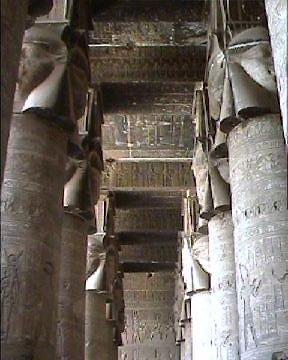
 Denderra:
(The 'House of Hathor').
Denderra:
(The 'House of Hathor').
The Temple of Hathor at
Dendera was found originally buried in sand. It includes astronomical
representations of the constellations, the zodiac symbols and several
interesting hieroglyphs.
The Temple of Hathor, at
Dendera was dated through astronomical information to 1,700 BC, from the
18th Dynasty.
(1)
The catacombs that run under the temple contain the enigmatic hieroglyphs and inscriptions so often quoted as
being 'electric light bulbs'.
While it is true
that the definitive interpretation of these
hieroglyphs is still uncertain, one has to ask of people who prefer to see them as
literal images, why electric bulbs would have physical snakes inside them.
(Click here for Map with
Location)
|
Denderra: ('Dendera', 'Denderah', 'Tantere'). |
Ancient Egyptian
Iunet
or Tantere,
known to the Greeks as
Tentyris, was the capital of the 6th
nome
of Upper Egypt and a town of some importance. Today, we know it as
Dendera. It is one of the best preserved temples, if not the
best, in all Egypt.
The
present building dates back to the times of the Ptolemaic
dynasty and was completed by the Roman emperor Tiberius, but it
rests on the foundations of earlier buildings dating back at
least as far as far as Khufu (pyramid builder Cheops, second
king of the 4th dynasty [c. 2613�c. 2494 BC]), in which was
found the celebrated zodiac now in Paris;
(2)
'The temple
complex, as it stands today, was built on the site of an older temple,
and is a replica of the original. The present building was first
initiated by Ptolemy III, with numerous additions by subsequent
Ptolemaic and Roman rulers. The inscription on the present temple,
states that the original building was erected in the far pre-Dynastic
times, by the followers of Heru (Horus). Archaeological evidence shows
that Khufu built a temple, presumably on this site. During the reign
of Pepi I (2289-2255 BC), the Enet-ta-ntr Temple was rebuilt. Several
subsequent Pharaohs left their marks on this important site'.
(4)
|
Astronomy at Dendera.
The Temple of Hathor at Dendera contains numerous astronomical images within the
complex.
The temple itself and surrounding buildings
are cardinally orientated.
The Ceiling of the Hypostyle:
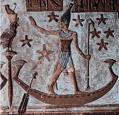 The
ceiling is decorated with vultures, winged disks, and the union
between Hathor and Horus. The colours are beautiful and are mostly
still original. The rest of the ceiling is a symbolic
representation of the north and south halves of the sky, the hours
of day and night, the constellations and the regions of the moon
and sun. The bays to the right show the northern stars while the
left shows the southern stars. The figures of Nut dominate each
end of the hall. The continuing cycle of a day is represented by
Nut. Her dress is the sky; between her legs is the birth of the
sun, which disappears at night as she swallows it. The
ceiling is decorated with vultures, winged disks, and the union
between Hathor and Horus. The colours are beautiful and are mostly
still original. The rest of the ceiling is a symbolic
representation of the north and south halves of the sky, the hours
of day and night, the constellations and the regions of the moon
and sun. The bays to the right show the northern stars while the
left shows the southern stars. The figures of Nut dominate each
end of the hall. The continuing cycle of a day is represented by
Nut. Her dress is the sky; between her legs is the birth of the
sun, which disappears at night as she swallows it.
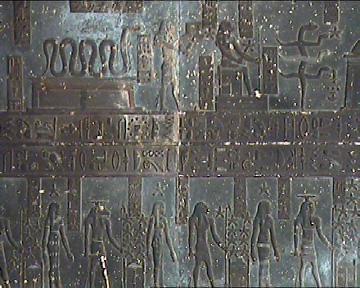
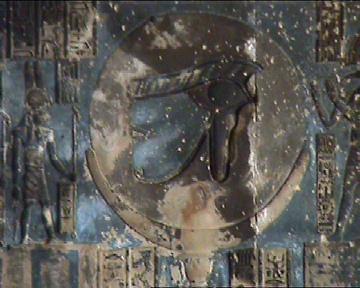
The now
famous zodiacs discovered at Dendera show constellations mostly
similar to those still used today. The largest display covers the ceiling of the
entrance hall of the temple of Hathor, and includes much astronomical
information alongside images of mythological creatures, deities and
symbolism with meanings only guessed at today.
The
'Round' Zodiac of Dendera:
Although the original is now in the Louvre in
Paris, a plaster replica is still to be seen at the temple.
The
'round' zodiac was carved onto the ceiling of a room,
it is a planisphere or map of the stars on a plane
projection, showing the 12 constellations of the zodiac , some of which are
represented in the same way as they are today (e.g. the Goat (Aries, The
Bull, Taurus, The Scorpion, Scorpio and Aquarius, the water bearer).
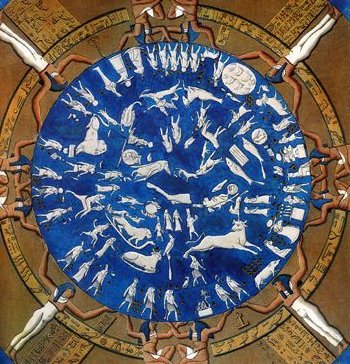
Lockyer
found hieroglyphs that were determined to represent setting and rising stars,
and from which the temple was subsequently dated. It was realised that this
zodiac showed a time anterior to its construction and it was suggested that it
may have been reproduced from an earlier copy, with a summer solstice
orientation. (1)
( Click
here for Detailed Image)
|
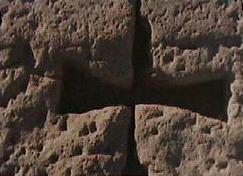
Construction Techniques.
Metal brick-ties (right) - It
has been noticed that the builders of the temple of Hathor used metal
brick-ties, one of many similar construction features found on ancient
structures around the world. The softness of the metal is believed
to have prevented serious movement between the blocks.
(More
about prehistoric Construction Techniques)
|
Offering pipes at Dendera:
The
following pictures are from Dendera and are described as 'offering's'.
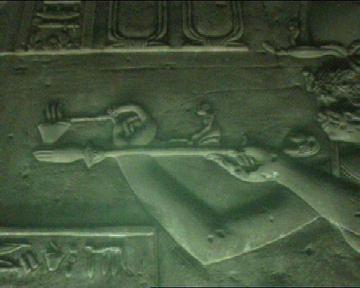
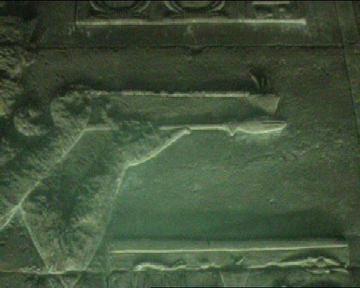
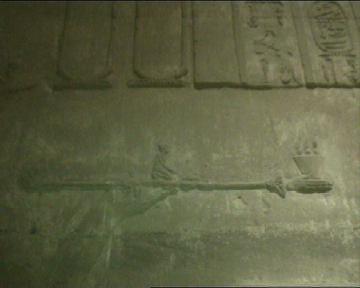
The importance of these
'offerings'
is evident in their presence, perhaps they were used as a means of
communicating with the higher
self...
It is clear from the
images that these 'offerings' were being inhaled, which opens a topic of
conversation rarely covered in archaeological text books, namely that
several Egyptian mummies have been found to contain traces of cocaine.
The sanctity and importance of such a place as the temple of Hathor at
Denderra suggests that this practice of inhaling such 'offerings' may
have been an important part of the priesthood rituals.
Although this by no
means proves that this is what we are looking at here, we are offered
a possibly valuable insight into the mind of the Egyptian priest.
The same ritual
' offering' pipes were described
in south America by Van Sertima
(6)
(More about this subject)
|
Myth and Legend:
One of
the roles of the goddess Hathor was
to support the skies, her four legs representing the cardinal
points of the skies.
|
The Underground Catacombs/Chambers.
The Temple of Hathor contains 12
underground tombs and
chambers.
While most are plain and undecorated, some have
walls of limestone rather than the sandstone of the temple itself,
that are covered with carefully carved reliefs (believed to have
been finished before the floor of the temple was laid).
The Hieroglyphs:
The following unique images are to be found at the end of one of
the underground tunnels. They have caused much debate in recent
times as they remain
to be completely interpreted.
Francois Daumas described the Hieroglyphs as follows:
In the last room, one sees, carefully carved on the
Southern wall, a falcon with detailed feathers, preceded by a snake
emerging from a lotus blossom within a boat. Whereas the whole of the
temple is constructed of sandstone, to facilitate a relief of fine
quality there was placed in the wall, at the level of the figures, a
block of limestone suitable for very detailed work, and of this the
artist took full and perfect advantage. These reliefs are cosmological
representations. The snake that comes out of the lotus is equated with
the shining deity Harsamtawy as he appears for the first time out of
the primordial sea. He is again represented near the bottom of the
crypt in the form of two snakes also coming forth, but this time
wrapped in lotuses like protective envelopes.
(5)
The two large 'bulb-like'
objects with snakes in them, have been
recently likened
to modern electrical appliances (i.e. wires and bulbs etc), In
this literal interpretation, we can also assume that pillars had
arms, and apes performed surgery.. based modern eyes. their
meaning is probably more complex, involving imagery to express a
concept rather than a physical object.
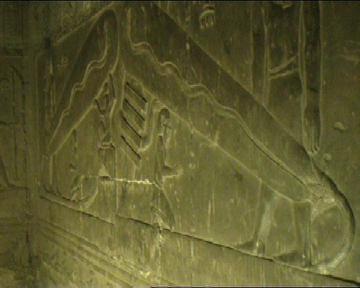
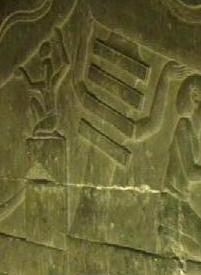
We can see that the 'Djedt'
appears to be supporting one of the two 'lamps'.
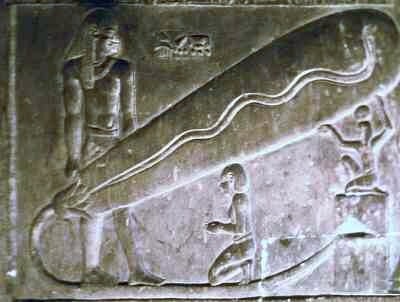
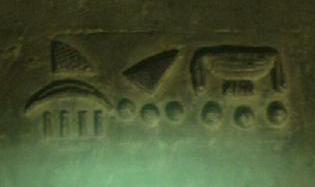
Note: The
symbols (Right) are embossed above the image on the left side.
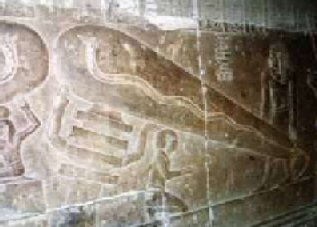
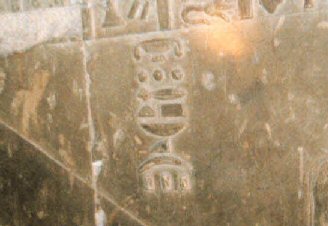
And these
(with central symbol changed) over the image on the right.
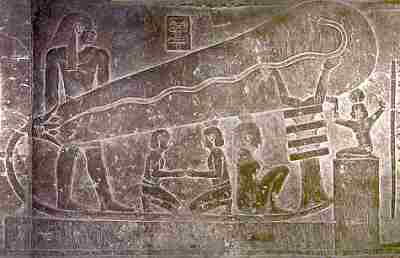
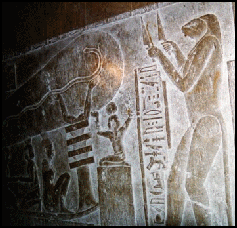
Another image at Dendera follows the same theme,
only this time the Djedt pillar is supporting the 'snake'
inside, and not the 'bulb'.
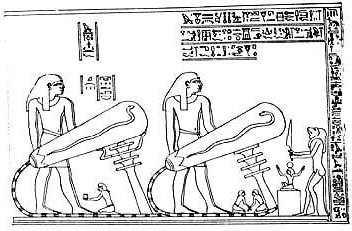
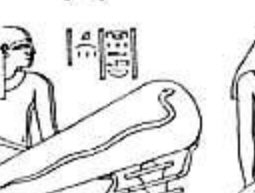
Note: The
same set of hieroglyphs over the figure on the left.
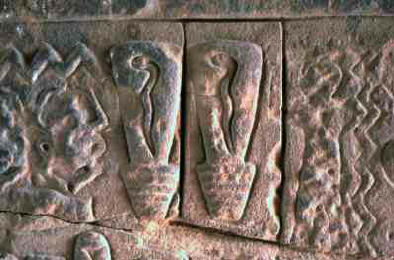
The same
two serpentine symbols can be seen elsewhere at Dendera.
|
(Other Egyptian Sites)
|

 The
ceiling is decorated with vultures, winged disks, and the union
between Hathor and Horus. The colours are beautiful and are mostly
still original. The rest of the ceiling is a symbolic
representation of the north and south halves of the sky, the hours
of day and night, the constellations and the regions of the moon
and sun. The bays to the right show the northern stars while the
left shows the southern stars. The figures of Nut dominate each
end of the hall. The continuing cycle of a day is represented by
Nut. Her dress is the sky; between her legs is the birth of the
sun, which disappears at night as she swallows it.
The
ceiling is decorated with vultures, winged disks, and the union
between Hathor and Horus. The colours are beautiful and are mostly
still original. The rest of the ceiling is a symbolic
representation of the north and south halves of the sky, the hours
of day and night, the constellations and the regions of the moon
and sun. The bays to the right show the northern stars while the
left shows the southern stars. The figures of Nut dominate each
end of the hall. The continuing cycle of a day is represented by
Nut. Her dress is the sky; between her legs is the birth of the
sun, which disappears at night as she swallows it. 
















